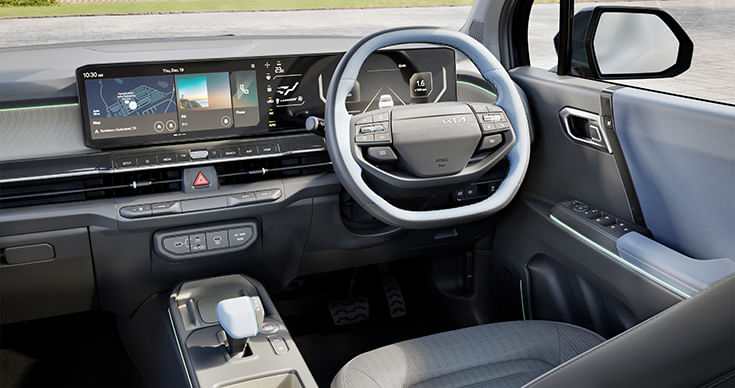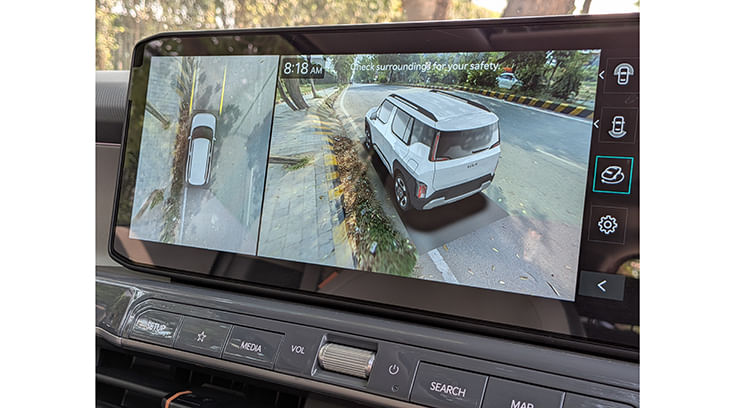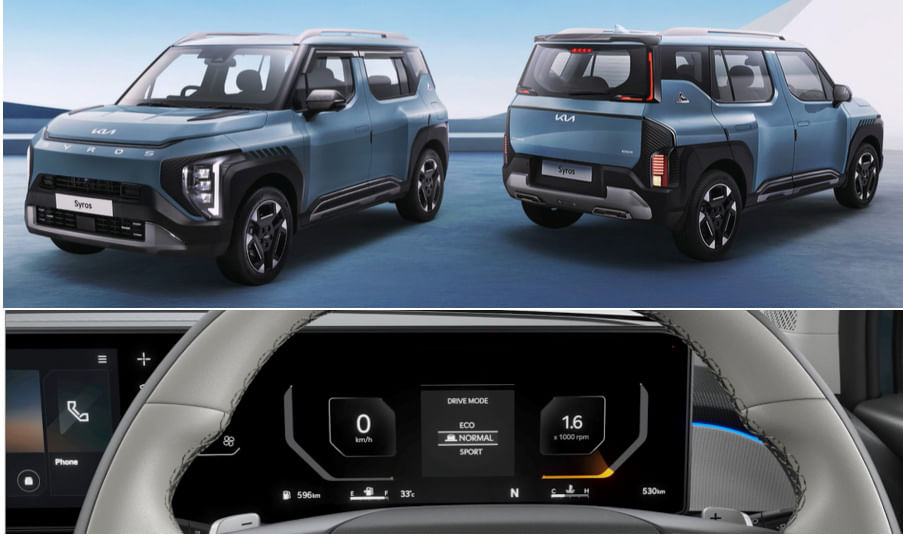Kia India, which introduced the sub-four-metre Syros SUV earlier this year in February, is redefining in-car technology in the segment with cutting-edge features that are differentiating its product, launched in both petrol and diesel options, from the rest of the market.
The Syros, which is mechanically based on a reinforced version of Hyundai Motor Group’s K1 small-car platform, gets a completely-new electrical and electronic (E/E) architecture that is enabling some of the most advanced features in this compact SUV, making it offer a far superior digital experience in the entire category.
To begin with, the Syros gets a central gateway that routes data between different ECUs or modules, while offering network security and control over data flow. This central data hub also provides a secure gateway for external communications by virtue of an embedded SIM (eSIM) in the vehicle telematics control unit (TCU) for enabling various cloud-based services.
The central gateway supports CAN, LIN, as well as Ethernet communication protocols with the latter, according to Kia, being available for select ECUs, likely those for high-bandwidth modules such as advanced driver assistance systems (ADAS), telematics, and infotainment. The Kia Syros comes equipped with an integrated triple-display setup, resulting in a perpetual 30-inch digital cockpit that seamlessly combines the 12.3-inch central in-vehicle infotainment (IVI) system, the 12.3-inch driver digital instrument cluster, and a 5-inch automatic climate control screen bridging the two bigger displays.
 The Kia Syros has an integrated triple-display setup, resulting in a perpetual 30-inch digital cockpit.
The Kia Syros has an integrated triple-display setup, resulting in a perpetual 30-inch digital cockpit.
The control module or ‘silver box’ driving these high-definition screens houses on-board processing power for media integration, wireless connectivity such as Bluetooth and WiFi, as well as vehicle telematics. The IVI offers a top-notch software experience, with well-defined menus and large-sized icons and fonts that result in an extremely fluid, interactive and safety-oriented human-machine interface (HMI) which is focused on minimising driver distraction by amalgamating touch-based controls with physical buttons on the car’s centre console as well as steering wheel.
Clear functional demarcation with the use of scroll-type buttons for adjusting media volume or running through various cluster menus, and toggle switches for changing audio tracks, further embellish the sophisticated HMI layout in the Syros.
 Syros gets Over-the-Air (OTA) update capabilities extending beyond the IVI, with upto 16 controllers that can receive on-the-go upgrades for continuous improvements.
Syros gets Over-the-Air (OTA) update capabilities extending beyond the IVI, with upto 16 controllers that can receive on-the-go upgrades for continuous improvements.
Advanced Cloud Integration
Augmenting the digital experience is the Syros’ cloud integration, wherein the compact SUV leverages the eSIM connectivity for external data transmission that enables various services under the Kia Connect 2.0 suite by communicating with Kia’s cloud server.
According to the company, the Syros gets Over-the-Air (OTA) update capabilities extending beyond the IVI, and encapsulating up to 16 controllers that can receive on-the-go upgrades for continuous improvements. Furthermore, real-time vehicle health monitoring and remote diagnostics are some of the key features that leverage the car’s telematics system to communicate with the cloud.
Under the Kia Connect Diagnosis suite, the system continuously collects data from various ECUs inside the vehicle, thereby tracking key systems such as engine, transmission, battery, brakes, and airbags, among others, and monitors them for any anomalies or fault codes. The detection of an error triggers in-car alerts through the infotainment display, while also enabling cloud-based remote diagnosis that can suggest on-the-go troubleshooting or offer the option to schedule a visit to the service centre, directly through the IVI.
Coupled with a mobile phone application, the diagnosis suite also maintains a data log of historical service records, service intervals, and upcoming preventive maintenance schedules, to offer a complete digital experience to the vehicle user by leveraging cloud-based data analytics and machine learning to monitor vehicle health appropriately. The connectivity layer in the Syros could also likely enable the carmaker to explore subscription-based services in the future, which is a key element of the industry’s transition towards software-defined vehicles or SDVs.
 A 360-degree camera with high-definition feed on the 12.3-inch central in-vehicle infotainment (IVI) system ensures safe and convenient maneuvering in tight parking and city driving conditions.
A 360-degree camera with high-definition feed on the 12.3-inch central in-vehicle infotainment (IVI) system ensures safe and convenient maneuvering in tight parking and city driving conditions.
Core attributes of the Syros
With a digital-first approach, the Kia Syros offers a highly-advanced and thoroughly modern driving experience, with features such as wireless Apple CarPlay and Android Auto connectivity, electric parking brake with auto hold, and a 360-degree surround-view camera bringing high levels of convenience and safety while manoeuvring the compact SUV even in dense city traffic.
An 8-speaker Harman Kardon audio setup, and segment-first electronic features such as seat ventilation for front as well as rear seats, a panoramic sunroof, and multilingual voice-enabled functions such as those for window operation, further enhance the in-cabin experience. While six airbags and ESC are part of the standard safety equipment, higher trims of the Syros feature radar- and vision-based Level-2 ADAS suite with adaptive cruise control (ACC), front collision-avoidance assist, high-beam assist and lane-keep assist (LKA) acting as key active safety functions.
 The Syros’ 1.0-litre petrol and 1.5-litre diesel engines get three drive modes – Eco, Normal and Sport.
The Syros’ 1.0-litre petrol and 1.5-litre diesel engines get three drive modes – Eco, Normal and Sport.
The compact SUV gets two engine options – a 1.0-litre, three-cylinder, 118hp and 172Nm GDI mill – and a 1.5-litre, four-cylinder, 114hp and 250Nm turbo-diesel unit. While both engines get a 6MT as standard, the petrol comes with the option of 7-speed DCT, whereas the SCR-based diesel engine gets a 6-speed torque-convertor automatic unit as the more convenient choice. Both engines are calibrated for linear power delivery with a strong mid-range performance that aids driveability in both city and highway conditions. The engines get three drive modes – Eco, Normal and Sport – each seeing a noticeable change in the power-delivery map as well as steering feedback, while there are three ESC-based traction modes (sand, mud and snow) on offer to provide adequate traction depending upon the road surface.
The Syros comes with 15-, 16-, and 17-inch wheel sizes depending upon the trim, with a McPherson strut coil spring setup at the front, and a coupled torsion beam axle doing duty at the rear. Despite the large rim size in the higher variants, the suspension setup is calibrated to offer a pliant ride quality, with good straight-line stability even at high speeds wherein body roll becomes evident due to the boxy silhouette of the compact SUV that also sees aerodynamic efficiency being one of its few limitations.
With a tall-boy design that emphasises on liberating the maximum room inside the cabin, and segment-first sliding and reclining rear seats, the Kia Syros offers a comfortable and modern in-cabin experience that is targeted at young family buyers. With an advanced E/E architecture, the car is also future ready to house electrified powertrains that will further utilise the maximum potential of such an agile and advanced digital platform. While the ICE Syros is positioned as a well-differentiated product, Kia India is likely to launch the all-electric Syros in early CY2026.
